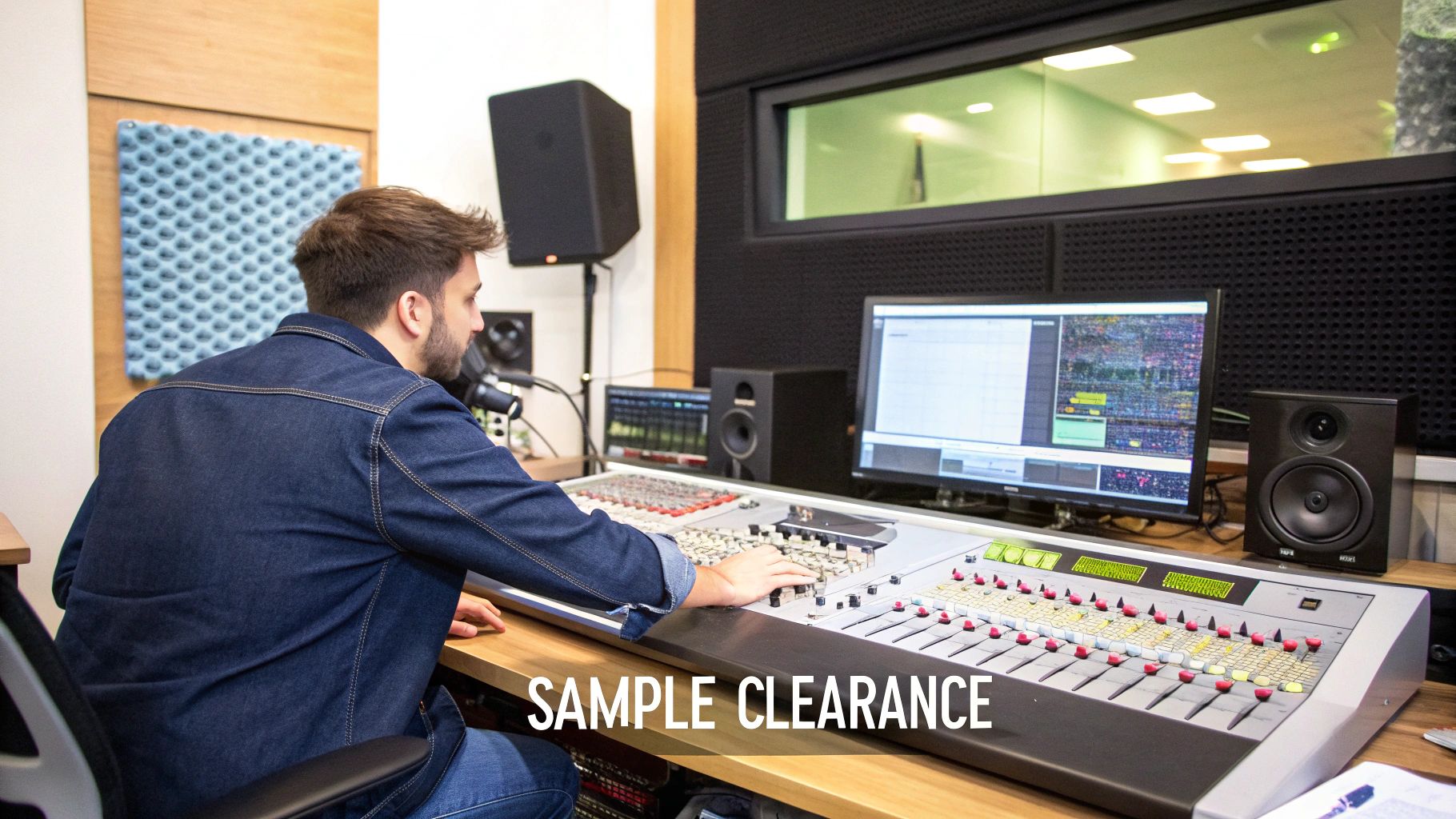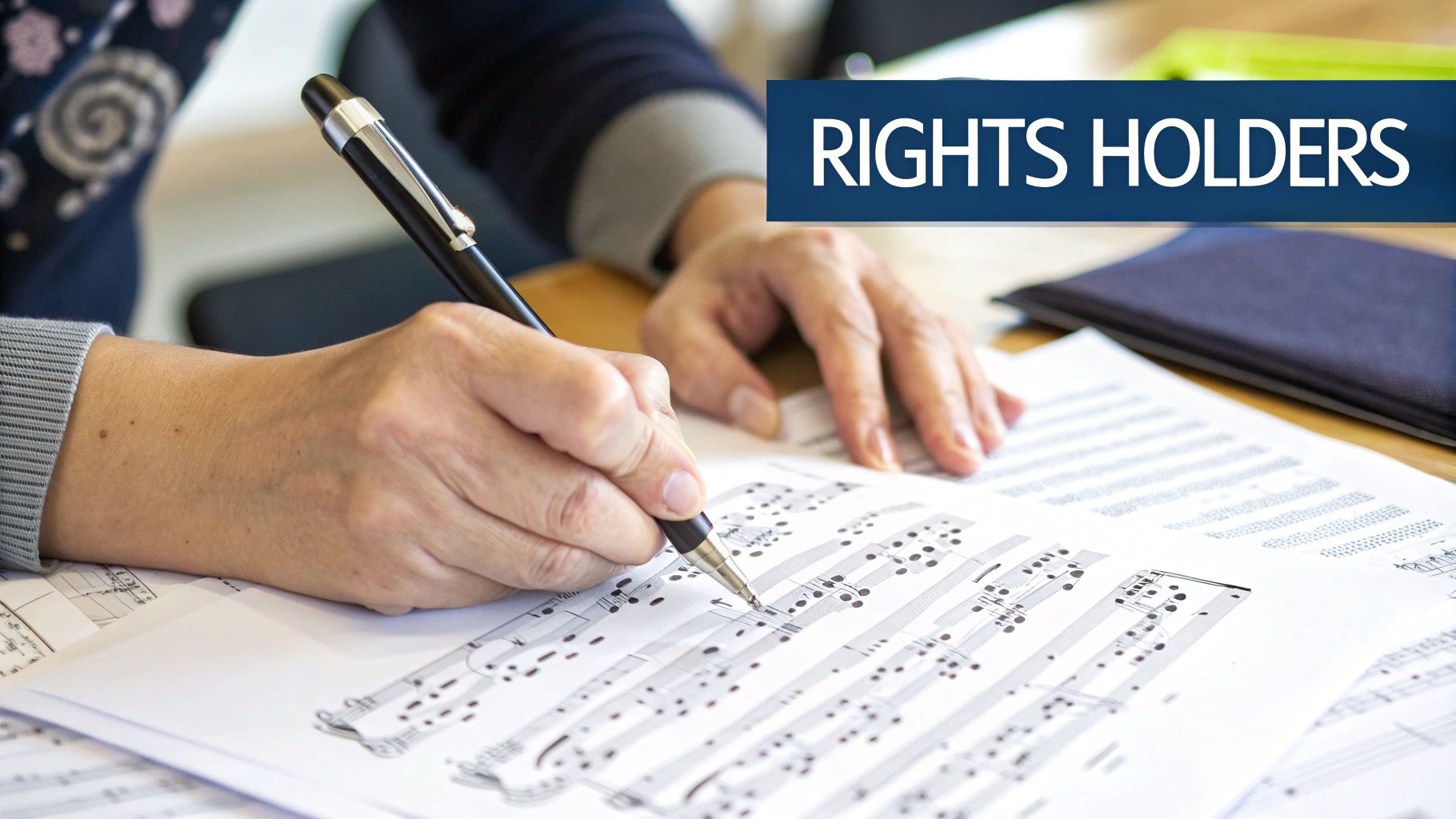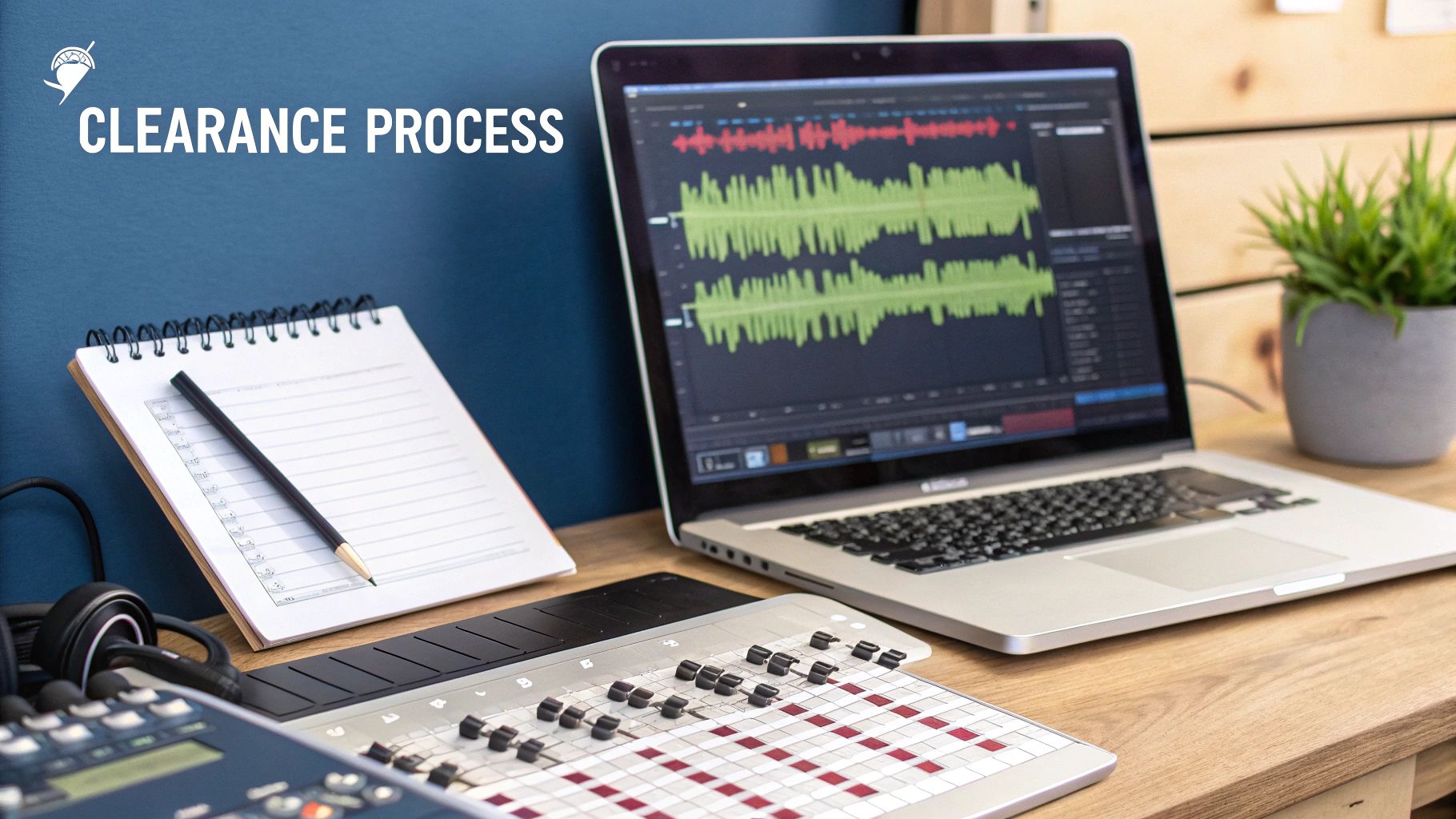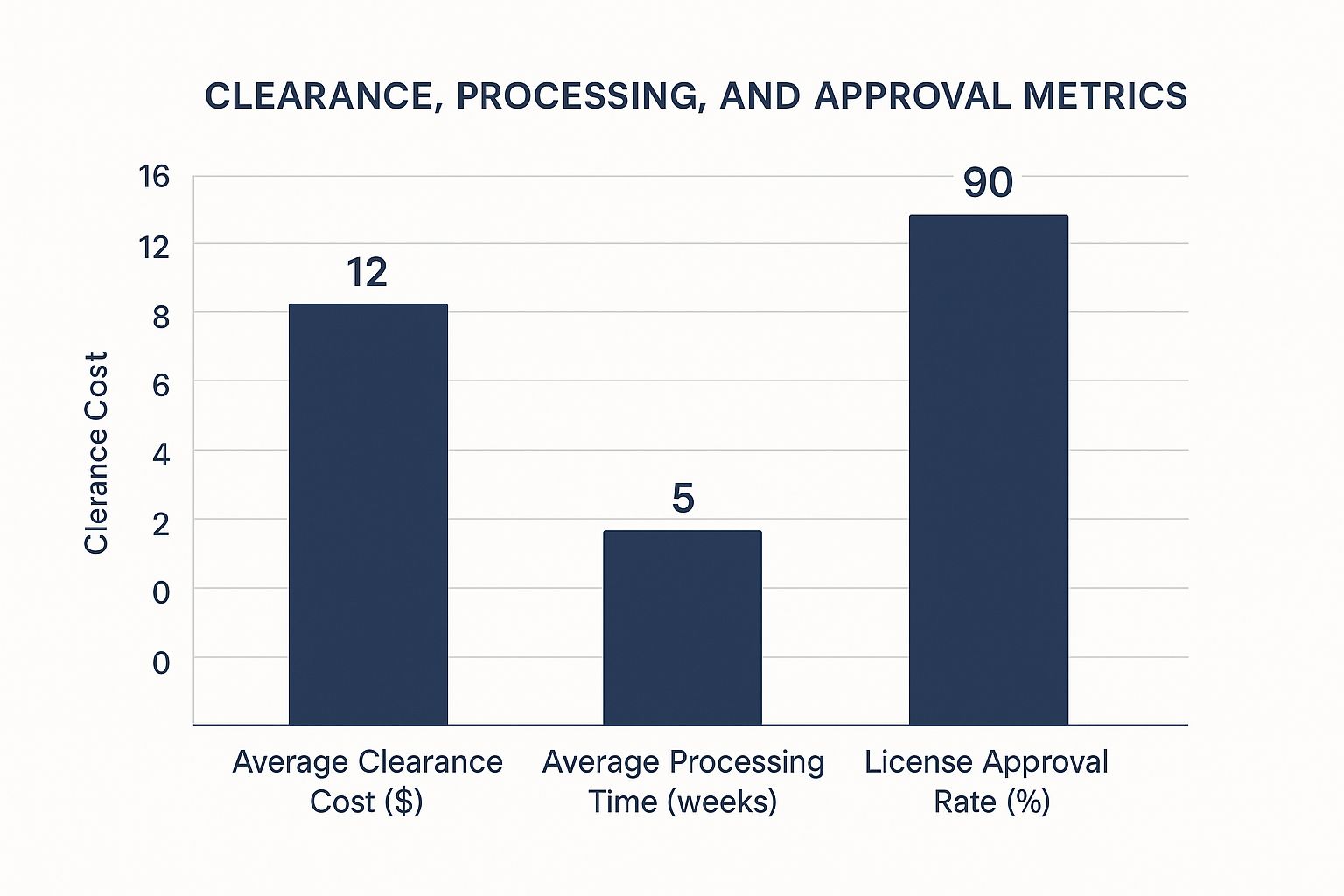Navigating the Music Sample Clearance Landscape

Music sample clearance can feel overwhelming. However, for artists working with samples, grasping the process is essential. It boils down to respecting the original creators and safeguarding yourself from legal trouble. For further information on the music industry, check out the Tevello Blog. Securing the proper rights allows you to use parts of pre-existing recordings in your music legally. This authorization ensures you can incorporate samples without worrying about copyright infringement.
Understanding Music Rights
Two primary rights are associated with music sample clearance: master recording rights and mechanical rights. Master recording rights pertain to the actual sound recording. For instance, if you want to use a piece of a specific artist's performance, you'll need to acquire these rights.
Mechanical rights, conversely, cover the underlying musical composition: the melody, lyrics, and harmony. These are separate from master recording rights, and both must be cleared for legal use.
When Do You Need Clearance?
A common misconception is that short samples or significantly altered samples don't require clearance. This isn't the case. Technically, any use of copyrighted material, no matter the length or how much you change it, necessitates clearance.
A key moment in music sample clearance history is the 1991 case Grand Upright Music, Ltd. v. Warner Bros. Records Inc., which significantly impacted sampling in hip-hop and other genres. This case, involving rapper Biz Markie, established that unauthorized sampling is copyright infringement. Learn more about this legal precedent and its impact on music sampling. Before this ruling, artists often sampled freely. Afterward, the average number of samples per track decreased noticeably.
Identifying Clearance Needs
Savvy producers consider clearance from the outset of their creative process. This proactive strategy saves time and prevents potential legal issues later. They ask themselves key questions: Is this sample crucial to my track? Could I create a similar sound without a copyrighted sample?
Addressing these questions early helps avoid costly clearance problems down the road. This foresight streamlines the workflow and minimizes legal risks.
Legal Frameworks That Shape Sample Clearance Decisions

Navigating music sample clearance involves more than just understanding copyright. It requires a grasp of complex legal principles like fair use, substantial similarity, and transformative use. These concepts can significantly impact your sampling strategy and ultimately determine the legality of your sample use. This section explores these key principles and provides practical guidance for music producers.
Fair Use: A Balancing Act
Fair use is a legal doctrine that allows limited use of copyrighted material without obtaining permission from the rights holders. However, it's not a blanket license. Courts consider four factors: the purpose and character of your use, the nature of the copyrighted work, the amount and substantiality of the portion used, and the market impact on the original work.
For instance, using a sample in an educational context is more likely to be considered fair use compared to using it in a commercial track.
Substantial Similarity: The Blurred Lines
Substantial similarity assesses whether your sample is too close to the original, both melodically and rhythmically. This concept is nuanced, as seen in the "Blurred Lines" lawsuit, where even a similar "vibe" was deemed infringement.
This underscores the importance of understanding the legal ramifications of sampling, even without directly copying the melody. Learn more about this and other sampling-related topics in our article about sampling music laws.
Transformative Use: Adding Your Creative Touch
Transformative use applies when a sample is altered significantly, giving it a new meaning or message. This defense argues that the original material has been transformed into something distinct. Simply speeding up a sample or adding a drumbeat might not suffice. The transformation must be substantial.
International Considerations: A Global Perspective
Releasing music internationally adds another layer of complexity. Copyright laws differ between countries. What's considered fair use in one country might be infringement in another. Some countries have stricter sampling rules than the U.S.
Understanding the specific laws of each territory where you plan to distribute your music is essential. This global perspective is key for successful music sample clearance.
To illustrate the complexity of this issue, let's examine some key court cases that have shaped music sampling practices. The following table highlights some landmark decisions and their impact on the music industry.
Key Music Sample Clearance Court Cases and Their Impact
This table outlines landmark legal cases that have shaped music sample clearance requirements and practices
| Case Name | Year | Artists Involved | Key Ruling | Industry Impact |
|---|---|---|---|---|
| Grand Upright Music, Ltd. v. Warner Bros. Records Inc. | 1991 | Biz Markie vs. Gilbert O'Sullivan | Unauthorized sampling constitutes copyright infringement | Established the precedent for obtaining clearance before releasing music containing samples. |
| Campbell v. Acuff-Rose Music, Inc. | 1994 | 2 Live Crew vs. Roy Orbison | Parody can be considered fair use | Clarified the application of fair use in the context of music sampling. |
| Bridgeport Music, Inc. v. Dimension Films | 2005 | N.W.A vs. Funkadelic | Even minimal sampling requires licensing | Further reinforced the need for clearance, even for short or altered samples. |
These cases demonstrate the evolving legal landscape surrounding music sampling and highlight the importance of seeking legal advice when navigating these issues. Staying informed and proactive is crucial for protecting yourself and your music.
Sample Clearance in the Digital Streaming Era

Music sampling has changed drastically with the rise of digital streaming. This new landscape presents both challenges and opportunities for producers. From workflow adjustments to budgeting considerations, the shift affects the entire music creation and release process. Streaming services, along with new AI-powered tools and digital fingerprinting, have significantly altered the playing field.
The Impact of Technology on Sample Clearance
Platforms like YouTube and Spotify use digital fingerprinting technology to identify samples with incredible accuracy. This technology is a cornerstone of Content ID systems, which automatically detect copyrighted material in uploaded content. This means even the smallest, modified samples have a higher chance of being flagged.
The growing use of AI tools is also simplifying the process of identifying rights holders. While this can speed up clearance, it also makes it more likely that uncleared samples will be found. Knowing the ins and outs of digital rights is essential for navigating music sample clearance in the current market. For a deeper understanding of this topic, you can check out this helpful guide on Digital Rights Management.
Adapting to the Digital Age
Both independent artists and major labels are adapting their sampling strategies in response to these changes. Many are now turning to pre-cleared sample marketplaces to bypass lengthy clearance processes.
These marketplaces offer pre-licensed samples, streamlining workflow and ensuring legal compliance. However, this approach can feel creatively restrictive for artists who prefer the thrill of discovering unique, obscure samples.
The rise of digital music has profoundly impacted sample clearance, largely due to the explosion of recorded music. By the end of 2022, there were roughly 193 million unique recordings worldwide, growing at a rate of over 20% annually for the preceding five years. This growth is partly fueled by the ease of digital production and greater access to samples. Interestingly, despite this surge in recorded music, listening time has stayed relatively consistent, leading to an imbalance between supply and demand. More detailed statistics can be found here.
Navigating Content ID and Pre-Cleared Samples
Producers now need to understand Content ID systems. Knowing how these systems operate and how to handle disputes can prevent release interruptions. Effectively using pre-cleared sample marketplaces allows artists to prioritize their creative process without getting bogged down by legal complexities.
Combining strategic navigation of Content ID systems and using pre-cleared samples is key for producers who want to stay ahead. This proactive approach is crucial in the present digital environment. For more on the business side of music, you can learn about the importance of Performing Rights Organizations, like ASCAP, BMI, and SESAC, in this article: What is a Performing Rights Organization and Why Independent Musicians Should Join One.
The Real Costs of Sample Clearance: Budgeting Strategies

The infographic above gives us a good overview of the average costs, processing time, and approval rates for music sample clearance. It highlights the financial and time commitment involved. Securing clearances can be a significant investment, with costs varying and approval not guaranteed. This underscores the importance of careful budgeting and realistic expectations when using samples.
Calculating Clearance Costs
Understanding how these costs are calculated is crucial for effective budgeting. Several factors influence the final price. These include the sample's prominence in your track, the original song's popularity, and the intended usage type.
For instance, a prominent sample from a popular song will likely cost more than a short, obscure one. Usage types, such as a commercial release versus use in an online video, also impact the cost.
Additionally, the rights required – master and publishing – play a significant role. Obtaining both often increases the overall cost. This requires careful negotiation and a clear understanding of your project's needs.
To illustrate the typical costs associated with different usage scenarios, let's take a look at the table below:
Average Sample Clearance Costs By Usage Type
| Usage Type | Master Rights Cost Range | Publishing Rights Cost Range | Total Estimated Cost | Additional Considerations |
|---|---|---|---|---|
| Online Video (Non-Commercial) | $50 – $500 | $50 – $500 | $100 – $1,000 | Often easier to secure, but usage restrictions may apply. |
| Commercial Release (Single) | $500 – $5,000 | $500 – $5,000 | $1,000 – $10,000 | Higher costs due to broader distribution and potential revenue. |
| Major Film/TV Synchronization | $5,000 – $25,000+ | $5,000 – $25,000+ | $10,000 – $50,000+ | Costs significantly increase with project visibility and sample prominence. |
| Live Performance | $50 – $250 per show | $50 – $250 per show | $100 – $500 per show | Costs can vary depending on venue size and audience reach. |
This table provides a general overview and actual costs can vary widely. Negotiating favorable terms and understanding your specific needs are vital for successful sample clearance.
Negotiating Favorable Terms
After identifying the necessary rights and contacting the rights holders, negotiating favorable terms is crucial for managing your budget. This can involve exploring different payment structures, such as royalty splits versus upfront payments.
A royalty split means sharing a percentage of your song's earnings with the rights holders. An upfront payment is a one-time fee. The best option depends on your individual circumstances and projected earnings. Sample clearance represents a significant cost, especially in major music markets. Learn more about the financial side of the music industry here.
Budget-Friendly Alternatives
For independent artists with limited budgets, exploring cost-effective alternatives is essential. Pre-cleared sample libraries offer a readily available and affordable source of samples, eliminating the complexities and costs of traditional clearance. These libraries provide a wide variety of genres and styles, offering flexibility for your projects.
Another alternative is commissioning original compositions. This allows you to obtain unique, custom-made music without the legal and financial burdens of sampling. While commissioning might have an upfront cost, it grants complete ownership and creative control, offering long-term value and avoiding potential legal issues.
By considering these budgeting strategies and alternatives, you can make informed decisions that balance your creative vision with your financial realities. Planning ahead and understanding the complexities of sample clearance will help protect your work and maintain your artistic freedom, ensuring your music can be shared and enjoyed without legal or financial obstacles.
Music Sample Clearance: A Step-by-Step Roadmap
Clearing a sample can feel overwhelming, but a structured approach makes the process much more manageable. This roadmap breaks down the process into clear steps, offering practical advice based on real-world producer experiences.
Identifying the Rights Holders
Before contacting anyone, identify who owns the rights. This includes both the master recording rights (typically owned by the artist or label) and the publishing rights (owned by the songwriter and publisher). Resources like ASCAP, BMI, and SESAC can help with this research.
For example, if you sample a song released by a major label, you'll likely contact the label for the master rights and the publisher(s) for the mechanical rights. This initial research is crucial for a smooth clearance process.
Crafting Effective Outreach
Once you've identified the rights holders, create a clear and concise request. Explain who you are, how you plan to use the sample, and include a link to your track. This professional approach can significantly improve your chances of a positive response.
Be prepared to discuss your budget. Having a realistic figure in mind helps expedite the negotiation process. Demonstrating that you understand the sample's value strengthens your request.
Submitting Proper Requests
When making your request, be specific about the sample duration, how it’s used in your track, and your project's scope (e.g., commercial release, online video). This information is crucial for the rights holders to assess the sample’s value and potential impact.
Providing comprehensive information upfront streamlines communication, allowing you to address any questions promptly. This efficient approach can lead to faster clearance approvals. Consider consulting with a music lawyer when negotiating agreements.
Finalizing Agreements
After agreeing on terms, ensure everything is documented in a formal sample clearance agreement. This contract outlines the usage rights, payment terms (royalty split or upfront fee), and ownership details, protecting both parties involved.
The agreement should specify the territories where your song can be distributed and the license duration. A clear agreement prevents misunderstandings and potential disputes.
Overcoming Roadblocks
Sometimes, rights holders are unresponsive or quote unreasonable fees. In these cases, consider alternatives like pre-cleared sample libraries or creating a similar sound yourself. Persistence is key, but knowing when to explore other options is also important.
Multiple owners can complicate the process. Track each communication diligently, using spreadsheets or dedicated software. This organized approach helps manage multiple requests concurrently and keeps your project on track.
When to Handle Clearance Yourself vs. Hiring Experts
Music sample clearance is essential, but the approach can vary. Sometimes, a DIY approach works. Other times, professional help is a smarter move. This section explores the deciding factors, offering insights from producers at different career stages.
DIY Clearance: A Viable Option?
For artists with limited budgets or using lesser-known samples, handling clearance independently can be a practical choice. This involves contacting the rights holders directly, negotiating terms, and finalizing agreements. This can be cost-effective, especially when working with independent artists or smaller labels who are often easier to reach.
However, DIY clearance demands time, research, and good communication. Understanding copyright law and negotiation tactics is key to securing good terms. For example, sampling a song from a lesser-known artist on a small indie label might be manageable on your own.
The Value of Professional Clearance Services
As projects become larger and more complex, professional clearance services offer significant advantages. These services specialize in the often-complicated clearance process, using their expertise and industry contacts to secure permissions efficiently. For instance, if you’re sampling a popular song from a major label artist, a professional service's expertise becomes invaluable.
These experts handle the entire process, from finding rights holders to negotiating complex agreements. They provide essential legal advice, minimizing risks. This allows artists to focus on creating music, leaving the legal details to the professionals.
Cost-Benefit Analysis: DIY vs. Professional
Deciding between DIY and professional clearance often comes down to a cost-benefit analysis. For projects like mixtapes or non-commercial releases, DIY might be more economical. But for commercial releases or projects with prominent samples, professional help is often the better investment, despite the initial cost.
Consider the potential legal and financial risks of uncleared samples. Lawsuits and takedown notices can be far more expensive than professional clearance fees. This makes professional help a worthwhile investment for bigger projects.
Evaluating Potential Clearance Partners
Choosing the right clearance partner is critical. Look for services with a proven track record in your genre, showing they understand the specific complexities of your music. Strong industry connections are also important, aiding communication and negotiation with rights holders.
Transparency in fees and services is crucial. The service should clearly outline what their fees cover and what to expect throughout the process. This builds trust and ensures a smooth, efficient experience.
Ready to protect your music? Contact Cordero Law today for expert guidance on music sample clearance and other legal matters in the music industry. Our experienced team understands copyright law and can provide solutions tailored to your needs, ensuring your music is legally sound and ready for success.
